
Craven Cottage is a football stadium in Fulham, West London, England, which has been the home of Fulham F.C. since 1896. The ground's capacity is 24,500; the record attendance is 49,335, for a game against Millwall in 1938. Next to Bishop's Park on the banks of the River Thames, it was originally a royal hunting lodge and has a history dating back over 300 years.
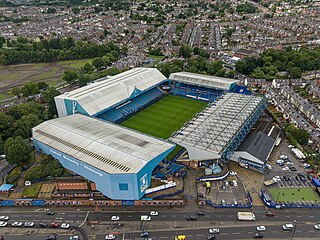
Hillsborough Stadium is a football stadium in Sheffield, England. It has been the home of Sheffield Wednesday since opening in 1899.

Shrewsbury Town Football Club is a professional association football club based in Shrewsbury, Shropshire, England. The team competes in League One, the third level of the English football league system.

Kenilworth Road, known affectionately as The Kenny, is an association football stadium in Bury Park, Luton, Bedfordshire, England. It has been the home ground of Luton Town since 1905. The stadium has also hosted women's and youth international matches, including the second leg of the 1984 European Competition for Women's Football final.
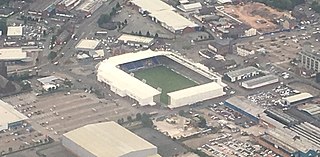
The Halliwell Jones Stadium is a rugby league stadium in Warrington, England, which is the home ground of the Warrington Wolves. It has also staged Challenge Cup semi-finals, the European Nations Final, the National League Grand Finals' Day, two games of the 2013 Rugby League World Cup and four games of the 2021 Rugby League World Cup.
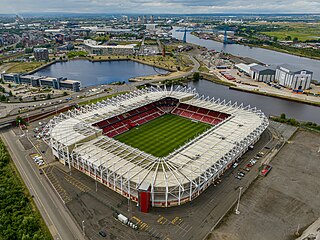
The Riverside Stadium is a football stadium in Middlesbrough, England, which has been the home of Middlesbrough since opening in 1995. Its current capacity is 34,742, all seated, although provisional planning permission is in place to expand to 42,000 if required.

Ewood Park is a football stadium in Blackburn, Lancashire, England, and the home of Blackburn Rovers F.C., founding members of the Football League and Premier League, who have played there since 1890. It is an all seater multi-sports facility with a capacity of 31,367, and four sections: the Bryan Douglas Darwen End, The Ronnie Clayton Blackburn End, the Riverside Stand, and Jack Walker Stand, named after Blackburn industrialist and club supporter, Jack Walker. The football pitch within the stadium measures 115 by 76 yards

The City Ground is a football stadium in West Bridgford, Nottinghamshire, England, on the banks of the River Trent. It has been home to Nottingham Forest F.C. since 1898 and has a capacity of 30,455.

Underhill Stadium was a stadium in Chipping Barnet, London, that was the home of Barnet Football Club between 1907 and 2013. The club's under-19 team played fixtures there; it was also the training ground of the London Broncos rugby league club, and hosted Arsenal reserve games until 2012. At the time of its closure, the stadium had a capacity of 6,023; it was demolished in 2018, and is now the site of the Ark Pioneer Academy, which opened in 2019. The stadium was famous for its slope from the North to South end.

Glanford Park is a football stadium in Scunthorpe, Lincolnshire, England, and is the home of National League North team Scunthorpe United.
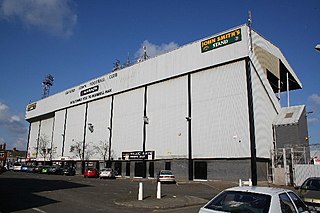
Blundell Park is a football ground in Cleethorpes, North East Lincolnshire, England and home to Grimsby Town Football Club. The stadium was built in 1899, but only one of the original stands remains. The current capacity of the ground is 9,052, after being made all-seater in summer 1995, reducing the number from around 27,000. Several relegations in previous years meant the expansion seating was also taken away; that reduced the capacity further from around 12,000 to what it is now.

New Meadow, also known as The Croud Meadow for sponsorship purposes, is a stadium situated on the southern outskirts of Shrewsbury, Shropshire, between the districts of Meole Brace and Sutton Farm, and close to the A5. It serves the home ground of English football club Shrewsbury Town.

The Vetch Field was a football stadium in Swansea, Wales. It was used for football matches and was the home ground of Swansea City until the club moved to the newly built Liberty Stadium in 2005. Opened in 1912, the ground held around 12,000 at the time of its closure, but upwards of 30,000 at its peak.
The Stadium Municipal d'Albi is a multi-purpose stadium in Albi, France. It is currently used for rugby league as the home ground of Racing Club Albi XIII and rugby union as the home of SC Albi. After an expansion project completed in 2007, the stadium holds 13,000 with 8,000 seated.
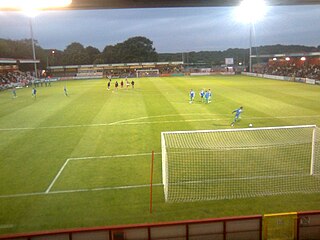
Broadhall Way, known as the Lamex Stadium for sponsorship purposes, is an association football stadium in Stevenage, Hertfordshire. It has been the home ground of Stevenage since the early 1960s, and has a capacity of 7,200 people.

The Recreation Ground, currently known as The EBB Stadium at The Recreation Ground for sponsorship reasons and informally known as The Rec, is a football ground in Aldershot, Hampshire, England. Football matches have been played there since 1927 when Aldershot was founded. The ground hosted league football between 1932 and 1992 when Aldershot were members of the Football League. Its current tenants Aldershot Town have used the ground since forming in 1992 and the ground once again hosted league football between 2008 and 2013.
A large number of English football clubs have ongoing schemes to redevelop existing grounds, or to move to newly constructed stadiums. A trend towards all-seater stadiums was initially prescribed by the Taylor Report, and was originally a condition only of Premier League admission. It has now become a requirement that within three years of a club's first promotion to the Championship all paying spectators are seated, even if the club is subsequently relegated. This page provides an (incomplete) list and description of those clubs who have planned new stadiums or refurbishments, or who have already moved/refurbished since around the time of the Taylor Report.
The history of Shrewsbury Town Football Club, an English football club based in Shrewsbury, Shropshire, dates back to the club's formation in 1886.
Meadow Park is a football stadium in Hempsted, Gloucester. It has been home to Gloucester City A.F.C. from 1986 to 2007. It was destroyed by flooding in 2007 and was rebuilt, with the first game being held in September 2020.
The 2007–08 season was the 108th season of competitive association football and 57th season in the Football League played by Shrewsbury Town Football Club, a professional football club based in Shrewsbury, Shropshire, England. Their seventh-place finish in 2006–07 and loss to Bristol Rovers in the 2007 Football League Two play-off final meant it was their fourth successive season in League Two. During the summer of 2007 the club moved home stadium from Gay Meadow, where they had played since 1910, to New Meadow. The season began on 1 July 2007 and concluded on 30 June 2008.


















